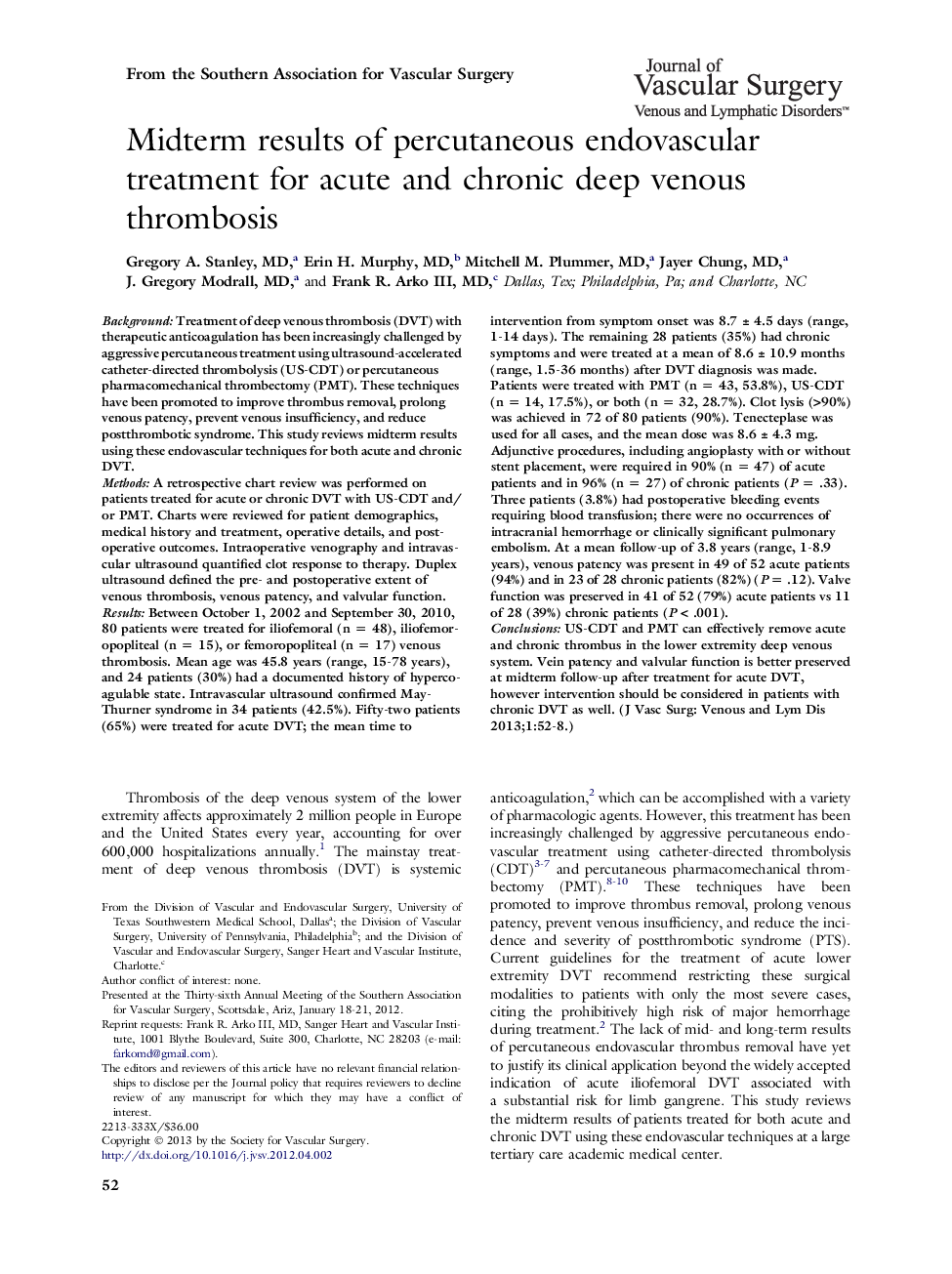| کد مقاله | کد نشریه | سال انتشار | مقاله انگلیسی | نسخه تمام متن |
|---|---|---|---|---|
| 2998186 | 1180228 | 2013 | 7 صفحه PDF | دانلود رایگان |

BackgroundTreatment of deep venous thrombosis (DVT) with therapeutic anticoagulation has been increasingly challenged by aggressive percutaneous treatment using ultrasound-accelerated catheter-directed thrombolysis (US-CDT) or percutaneous pharmacomechanical thrombectomy (PMT). These techniques have been promoted to improve thrombus removal, prolong venous patency, prevent venous insufficiency, and reduce postthrombotic syndrome. This study reviews midterm results using these endovascular techniques for both acute and chronic DVT.MethodsA retrospective chart review was performed on patients treated for acute or chronic DVT with US-CDT and/or PMT. Charts were reviewed for patient demographics, medical history and treatment, operative details, and postoperative outcomes. Intraoperative venography and intravascular ultrasound quantified clot response to therapy. Duplex ultrasound defined the pre- and postoperative extent of venous thrombosis, venous patency, and valvular function.ResultsBetween October 1, 2002 and September 30, 2010, 80 patients were treated for iliofemoral (n = 48), iliofemoropopliteal (n = 15), or femoropopliteal (n = 17) venous thrombosis. Mean age was 45.8 years (range, 15-78 years), and 24 patients (30%) had a documented history of hypercoagulable state. Intravascular ultrasound confirmed May-Thurner syndrome in 34 patients (42.5%). Fifty-two patients (65%) were treated for acute DVT; the mean time to intervention from symptom onset was 8.7 ± 4.5 days (range, 1-14 days). The remaining 28 patients (35%) had chronic symptoms and were treated at a mean of 8.6 ± 10.9 months (range, 1.5-36 months) after DVT diagnosis was made. Patients were treated with PMT (n = 43, 53.8%), US-CDT (n = 14, 17.5%), or both (n = 32, 28.7%). Clot lysis (>90%) was achieved in 72 of 80 patients (90%). Tenecteplase was used for all cases, and the mean dose was 8.6 ± 4.3 mg. Adjunctive procedures, including angioplasty with or without stent placement, were required in 90% (n = 47) of acute patients and in 96% (n = 27) of chronic patients (P = .33). Three patients (3.8%) had postoperative bleeding events requiring blood transfusion; there were no occurrences of intracranial hemorrhage or clinically significant pulmonary embolism. At a mean follow-up of 3.8 years (range, 1-8.9 years), venous patency was present in 49 of 52 acute patients (94%) and in 23 of 28 chronic patients (82%) (P = .12). Valve function was preserved in 41 of 52 (79%) acute patients vs 11 of 28 (39%) chronic patients (P < .001).ConclusionsUS-CDT and PMT can effectively remove acute and chronic thrombus in the lower extremity deep venous system. Vein patency and valvular function is better preserved at midterm follow-up after treatment for acute DVT, however intervention should be considered in patients with chronic DVT as well.
Journal: Journal of Vascular Surgery: Venous and Lymphatic Disorders - Volume 1, Issue 1, January 2013, Pages 52–58